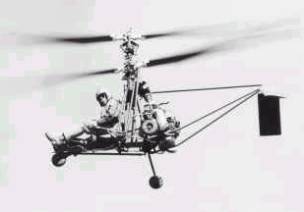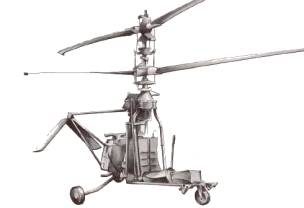
""
GYRODYNE
COMPANY
|
GYRODYNE |


|
|
|||||||||
|
Para
1955, luego de patentar su descubrimiento de los “tips” de pala,
Gyrodyne estaba buscando un diseño para aplicarlo en su rotor coaxial.
Encontró un pedido del U.S. Marine corps que buscaba un helicóptero
pequeño que pudiera ser lanzado detrás de las líneas enemigas, en el
cual un piloto pudiera rápidamente armar al helicóptero y volar de
regreso fuera de peligro. Este pedido se había basado en la experiencia
de la guerra de Korea, donde muchos pilotos cayeron en manos enemigas
debido a la falta de equipo de rescate. El contrato se firmo en
diciembre de 1954 y se construyeron dos prototipos que fueron designados
como XRON-1 Rotorcycle. Menos
de un año de la “autorización para proceder”, se realizó el
primer vuelo, el cual ocurrió el 23 de noviembre de 1955. Con un peso
total de 500 lb., un diámetro de rotor de 15 Ft y un motor de dos
tiempos de 40 HP era 11 veces mas pequeño que el modelo 2B. La alta
temperatura alcanzada por el motor Nelson, demostró que se necesitaba
otro motor. A
mediados de 1956, Gyrodyne requirió a la Naval Bureau of Aeronautics
(BuAer) que considerara el cambio de motor por un motor de automóvil
Porsche modificado. Gyrodyne recibió la aprobación y a finales de 1956
el XRON estaba volando nuevamente. A mediado de 1957, Gyrodyne tenia
tres modelos con tres motores diferentes:
Después
de probar las tres versiones para finales de 1957, la mas satisfactoria
fue la que equipaba el motor Porsche. Para eso obtuvo de las autoridades
el permiso para entrar en negociaciones con la compañía Porsche de
Alemania para desarrollar un motor estrictamente para ser aplicado sobre
el Rotorcycle. Como
consecuencia se obtuvieron dos modelos, el primero con una potencia de
55 HP y el segundo con una de 72 HP. Para principios de 1958 el modelo
Porsche de 55HP estaba disponible sobre un XRON de disco de rotor de 17
Ft de diámetro, el cual adquirió cinco unidades el Marine Corps para
evaluarlo. El
motor Porsche requería modificaciones mas grandes para ser utilizado.
Esto incluía una nueva transmisión y un rotor de 20 Ft. |
|||||||||
|
|
|||||||||
|
By
1955, Gyrodyne was looking for a helicopter contract to demonstrate
their new innovative yaw control for their coaxial rotor system. That
contract came in the form of U.S. Navy contract NOas 55-388-c. In this
contract, the U.S. Marine corps was looking for a small sized helicopter
that could be dropped to a stranded pilot behind enemy lines, in which
the pilot could quickly "snap together" the helicopter and fly
out of harms way. This contract had been issued shortly after the end of
the Korean War where many a fighter pilot had become captured due to a
lack of extraction capability. The contract had been awarded in
December 1954 and required the design, construction and test of two (2)
one-man helicopters which were designated as XRON-1 Rotorcycle. Less than one
year from the date of "authorization to proceed", the first
flight of the XRON-1 occurred on November 23, 1955. With a gross weight
of 500 lb. and a 15-ft. rotor diameter, the two-cycle 40 horse powered
XRON-1 was 11 times SMALLER than the 5400 lb model 2B! Flight testing by
the Marine Corps team soon began and the high cylinder temperatures
being generated by the Nelson indicated that engine life would be too
short to be successful. A different engine was needed. In
mid 1956, Gyrodyne requested the Naval Bureau of Aeronautics (BuAer) to
consider changing the XRON-1 engine to that of a modified Porsche
automobile engine. Gyrodyne received approval in late 1956 and by early
1957 the XRON-1 was flying again. While this was occurring, BuAer was
also proceeding on its own with the development of a small turbine
powered engine suitable for the XRON. By mid 1957, Mr. Papadakos now had
three engines powering his company's XRON helicopter:
With all three
versions having been tested by late 1957, the most satisfactory results
emerged from the Porsche combination. BuAer then authorized Gyrodyne to
enter into negotiations with the Porsche Company of Germany to develop a
suitable engine strictly for the Rotorcycle application. Accordingly,
two models were developed, the first one rated at 55 horsepower and the
second rated at 72 horsepower. By early 1958, the 55 HP Porsche was
available and was easily installed on the existing Porsche powered XRON
with a 17-ft rotor and was tested at NATC, Patuxent River, Maryland in
accordance with applicable specifications. The performance of the
helicopter led the Marine Corps to acquire five (5) of this type of XRON
Rotorcycle for evaluation purposes. The
72 horsepower Porsche engine required more extensive modifications to be
used. This included a new transmission to handle the higher power input
and a 20-ft rotor diameter to handle the higher empty weight. This XRON
was also evaluated at NATC, Patuxent River. Thanks to Gyrodyne Helicopters |
|||||||||
|
|
|
Characteristics |
Information |
Characteristics |
Information |
| First
Flight Primer Vuelo |
1955 |
Engine Motor |
1 Porsche |
| Seating
Capacity Plazas |
1 |
Power Potencia |
72 HP |
| Empty
Weight Peso Vacío |
550 Lb |
Hover
Ceiling O.G.E. Estacionario O.G.E |
4200 Ft |
| Maximum
Weight Peso Máximo |
906 Lb |
Hover
Ceiling I.G.E. Estacionario I.G.E |
6000 Ft |
| Vel.
Cruise Vel. crucero |
54 Kts |
Service
Ceiling Techo de Servicio |
11200 Ft |
| V.N.E. V.N.E |
66 Kts |
Maximum
Range (Std) Alcance (Std) |
46 NM |
Copyright © 1999 / 2003